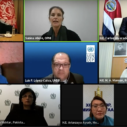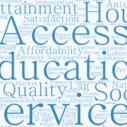
Search
‘It will be important to not let the “perfect” or “ideal” be the enemy of what is feasible based on availability’

Sunita Kishor, a prominent figure in the field of demographic and health research, brought her experience to the recent Expert Workshop on Improving the Collection and Availability of Multidimensional Poverty and Wellbeing Data as a distinguished discussant. As Director of the Demographic and Health Surveys (DHS) Project, her expertise is highly regarded in exploring the complexities of poverty and wellbeing measurement. In this interview, Kishor shares her insights on the imperative of balancing feasibility with perfection in data collection and analysis.
During the Expert Workshop, there was a focus on potential indicators across nine domains of human development. From your perspective, what will be the best way to explore new domains and questions on human development? How could current sources of data such as DHS be an option to explore those dimensions?
Exploration of new dimensions ideally requires literature reviews (largely done in this case, given the presentations at the meeting), qualitative in-depth studies, and/or pilots of some key questions including cognitive testing and fielding. To be comprehensive you would likely have to run a separate MPI survey programme. All expensive and time-consuming activities, of course. If a dedicated MPI survey programme cannot be mounted, then a realistic option is to identify and use existing data on these new and expanded domains.
Of the nine domains, several are at least partially covered in different surveys (including the DHS/MICS) and in-depth studies. In exploring the existing data, it will be important to not let the ‘perfect’ or ‘ideal’ be the enemy of what is feasible based on availability. That means that you need to use what already exists, and if absolutely necessary, propose either minor tweaks or minor additions to existing questions to get closer to data that may be more ‘perfect’.
Speaking for the DHS, under DHS-9 (April 2024–April 2029), country data needs, more than ever before, will drive modifications (inclusions/exclusions) to the questionnaire. Simultaneously, there is pressure to try and reduce the length of the questionnaires and, at a minimum, not increase it. This means that any addition will need a matching deletion -a tall order!
The workshop aimed to explore ways to complement the existing global Multidimensional Poverty Index (MPI) with a measure of ‘moderate’ multidimensional poverty on a global scale. What do you propose for achieving this goal, and what challenges do you foresee in implementing them?
The current MPI, even for low-income countries, is really capturing extreme poverty. Given this, there are two possibilities: using existing/available data, the thresholds be changed for relevant current variables to capture more poverty (and not just the poorest of the poor) in low-income countries and likely also the poorest households in middle-income countries. Even with changed thresholds for some indicators, other indicators would need to be swapped out altogether.
The other option is to rethink the MPI to expand and include key new indicators for several of the domains to reflect a world where what it means to be poor has changed. For example, in today’s world even things like being disconnected from the internet, not having access to safe abortion, are new or re-emerging challenges. But then the question arises: where will these data come from at the household level? Some of these indicators–for example internet use-will be in DHSs, but clearly not all needed variables. However, most global surveys must also continue to respond to emerging needs. Thus, perhaps overtime data on many more of these indicators will become available.
You need to use what already exists, and if absolutely necessary, propose either minor tweaks or minor additions to existing questions to get closer to data that may be more ‘perfect’.
The workshop also touched upon measuring new aspects of poverty, such as deprivations related to the digital divide or environmental vulnerabilities. How do you envision integrating these emerging dimensions of poverty into existing measurement frameworks, and what are the key considerations in doing so?
Of the emerging dimensions some are more likely to make it into quantitative, country-owned surveys such as the DHS; others may need to be measured more tangentially just by their nature. For example, the digital divide is one that can be measured at the household level relatively easily in terms of access and use by women and men in the household. As I said above, DHS already has questions on cell phone ownership and internet access/use. However, environmental vulnerabilities are an area that is going to be challenging to measure directly through questions to household members.
The issue really is that while you can perhaps measure household vulnerabilities in specific areas (e.g., income loss, crop loss, livelihood loss, food deprivation) the data will not be able to tell you if this is the result of environmental issues or due to other reasons (political unrest, war etc.).
A survey could ask something like: Why do you think this has happened to you—but the answers would largely reflect perception. To look at the contribution of environmental issues, I think in most cases, you would need to overlay environmental indicators data (e.g., change in temperatures, tree cover) onto the geographic area where the household is located. For this to be effective across surveys and studies you need GPS information as part of the household data. Given the increased sensitivity across countries to releasing any data, GPS information is even more vulnerable to suppression.
At DHS, we use a standard process for displacing GPS data in order to protect confidentiality of households and sampling clusters, but data remain publicly available.
One of the insights highlighted during the workshop was the intense competition that data providers face for space within questionnaires. How do you suggest prioritising high-value survey questions while ensuring comprehensive coverage of the multidimensional aspects of poverty and wellbeing?
Some key elements of a strategy would be that the demand for the data comes from countries with how they would use the data for policy making; indicators should not be aspirational, but actionable—not ‘nice to know’ but well-defined with a clear denominator and numerator that resonates with governments and can be immediately ploughed into policy.
Indicators must be relevant for most of the population taking into consideration that there will be a sufficient number of cases that can be disaggregated by various characteristics and still have sufficient cases in each category.
Focus only on the absolutely key information—the tip of the iceberg that reveals that there is an iceberg and not the entirety of the iceberg.
This article was published in Dimensions 16
















